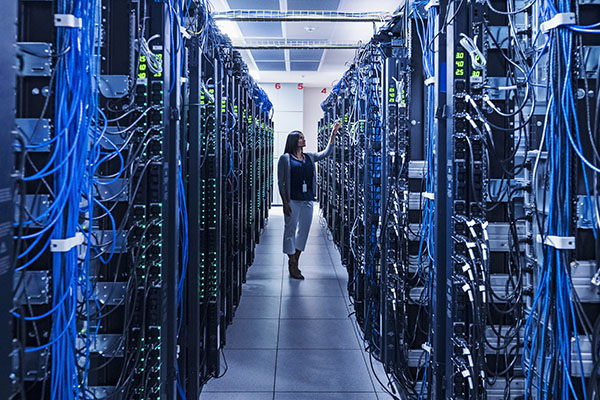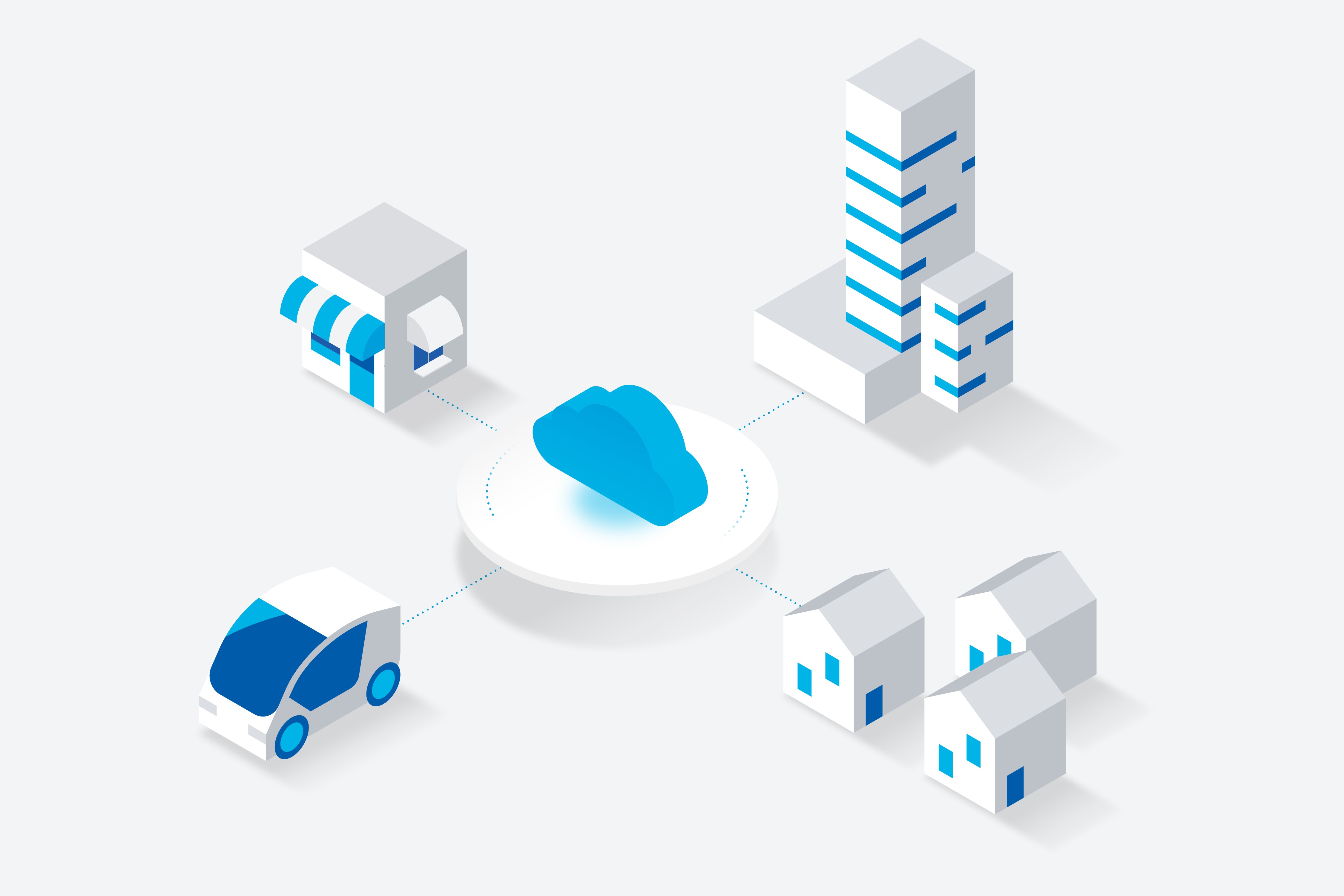Staying connected: Understanding your internet connections
Internet connections come in two categories: broadband and cellular. Within these categories are several types of connections. These include fiber, 5G, fixed wireless access, wireless broadband, cable, DSL, and satellite.
Not all internet connections are created equal. It’s important for all users to have a basic understanding of the different internet connection types to meet their needs and provide the best experience. For businesses, this understanding is essential to effectively support day-to-day operations. Knowing your options can help you evaluate the best connection based on your use cases and what’s available in your area.
Before we dive into understanding internet connections, access types, and how they provide connectivity, first understand how data moves across a network and why it matters.
How data moves across a network
Data traveling to and from your mobile, home, or business devices on your local network is divided into small pieces called packets. These packets feed into a core network like fiber, which transmits high-bandwidth, high-speed traffic. This core network acts as a data superhighway, transmitting these packets to their destination where the process is reversed, and data is reassembled on the receiving device.
Today, virtually all businesses require high-speed internet connections for day-to-day operations. The internet is essential for everything from simple tasks, like using an internet search engine or sending emails to customers, to supporting complex data-based operations, like cloud-based analytics and artificial intelligence (AI). Understanding how different internet connections work can help you make the best connectivity choices for the various uses you have for the internet in the office and in the field.
Types of internet connections
As we mentioned above, there are several types of internet connections. These range from ultra-fast and reliable networks like fiber and 5G to older technologies like DSL, which uses an existing telephone line to transmit data. The high-speed, low latency capabilities of fiber, for example, transmits data faster than high speed cable, giving it a significant edge when it comes to the data-demanding requirements of today’s applications.
What is a fiber internet connection?
A fiber internet connection uses fiber-optic cables that send data via light instead of electrical signals, allowing for extremely high speeds and bandwidth over long distances. Because fiber is buried underground, it’s shielded against interference, like weather, making it the most resilient and highest performing connection out there.
If your business needs reliable, secure cloud connectivity for platforms and bandwidth-intensive applications, business fiber internet provides that connectivity. Also, Wi-Fi—one of the ways to connect devices to the internet—connects devices to your business’s internet gateway to interact with your fiber connectivity. Together these technologies can deliver fast, reliable internet to your devices.
Fiber is currently available in over half the U.S. and growing fast.1 In fact, analysts estimate 1.12 billion fiber-capable connections will be available by 2030.2
What is 5G?
5G is the latest generation of cellular technology. It’s a cellular alternative to traditional broadband that doesn’t rely on physical cable like cable or DSL do. 5G operates by transmitting radio signals using antennas on towers, buildings, and structures. Mobile 5G offers broad coverage areas over low-band spectrum. There’s also 5G+, which offers mid-band spectrum and reaches average speeds up to 3x than of our 4G LTE in major metro areas. For business, it’s great for exploring new use cases to help drive innovation.
With these higher speeds also comes lower latency, which is the time it takes a device to send a message and get a response. Low latency is critical for mobile or wireless applications, systems, and devices that require near-instant sharing and processing of high-bandwidth data, such as in autonomous cars and manufacturing.
You’re probably most familiar with 5G through your smartphone, which enables you to connect to the internet on a mobile 5G network when coverage is available. Streaming videos, conducting video calls away from the office, or transmitting large amounts data from a mobile device like a smartphone or tablet—all happens faster and more reliably on 5G networks.
Although a 5G internet for business connection can function as your primary business connectivity or backup to fiber, some businesses also configure a Wi-Fi network in the 5G internet router gateway in order to connect multiple indoor business areas and devices.
What is fixed wireless access?
Fixed wireless access (FWA) is a type of broadband internet that uses radio signals to provide high-speed internet access to homes and businesses. Unlike cellular internet, which provides internet access to mobile devices, FWA delivers internet to a fixed location using radio signals from the same cell towers as those used by mobile devices.
Your internet service provider (ISP) sets up a base station as a central communications point at your location. Your connection is then established with an antenna or receiver that communicates with the base station. Your business can set up a Wi-Fi network or install Ethernet cables that communicate with the receiver to give you access to your connection.
Fixed wireless access comes with advantages over cable and DSL because your business has fewer cables to install and manage. And with 5G technology, speeds can be even higher to compete with legacy cable connections.
What is wireless broadband?
Wireless broadband is an internet technology that allows a mobile hotspot to broadcast a Wi-Fi signal for you to connect your devices. Your data is then sent via cellular to connect to the internet. While many smartphones can serve as a mobile hotspot for a few devices, this process consumes large amounts of data and creates a slower connection than a dedicated hotspot device being used as an access point.
Especially for on-the-go operations, wireless broadband via mobile hotspots can provide a faster, more reliable connection compared to cellular devices—like smartphones—alone. Many carriers allow you to add a mobile hotspot to your existing cellular plan, making the transition from cellular to wireless broadband easy.
What are cable and DSL connections?
Cable internet and DSL both rely on physical cable connections to transmit data via electrical signals. Although they’re still used today, these technologies increasingly come with some limitations.
Cable internet uses coaxial cables, like those used for cable television services. These connections are widely available and can maintain high internet speeds for certain plans. Compared to fiber, however, the shared bandwidth of cable internet can increase latency and slow down speeds—especially during peak usage times. Wi-Fi routers (in conjunction with cable modems) are common ways to connect to a cable internet connection, offering flexibility within a space at the cost of top-end speed.
DSL uses copper telephone lines already installed in homes and businesses to establish a connection to the internet. While these cables increase the availability of this type of connection compared to newer technologies, DSL has significantly higher latency and lower speeds. The further data must travel via a DSL connection, the slower the speeds get—compare this to fiber, which has significantly less signal loss over distance.
What is satellite internet?
Satellite internet is a type of broadband connection that sends and receives data via satellites that orbit the Earth in conjunction with ground stations on the surface. Given these signals are beamed to satellites without the need for physical cables, satellite internet can be available in areas other internet services cannot. Be it the middle of the ocean or in wilderness areas around the world, satellite internet offers a connection where others can’t deploy infrastructure as quickly given their remote nature.
With the distance the data must travel—up to 35,000 kilometers each way—satellite internet is often slower than fiber, 5G, or cable connections. Poor weather can also foul connections by interrupting signal transmission either to or from satellites and ground stations. Given the expensive nature of space-based infrastructure, satellite internet is usually more expensive as well.
You may need a combination of internet connectivity solutions for your business. As far as which combinations you need, that all comes down to how you plan to use the internet for your everyday use-cases. Each type may come with its own advantages and downfalls, and it is important to consider how you plan to sync with your internet connection, like with a Wi-Fi network or via mobile devices like smartphone.
Virtually all businesses today require high-speed internet connections. Understanding the differences and how they work can help you optimize your connections and troubleshoot along the way.
How Wi-Fi works with your internet connections
Business Wi-Fi, which is a way to connect to a broadband network via a router, doesn’t require every device to be wired into your broadband network. Your local Wi-Fi router (in conjunction with a cable modem, in some cases) distributes your connection locally, allowing multiple devices to connect to the internet simultaneously. Think about it this way: while your Wi-Fi network isn’t an internet connection itself, it is a way to connect to your internet connection wirelessly.
While Wi-Fi performance relies on factors like signal strength, number of connected devices, and bandwidth, a router or gateway using Wi-Fi 6 and 6E technology gives you faster speeds and greater bandwidth. The most recent standard, Wi-Fi 7, delivers even better speeds, nearly 5 times faster than Wi-Fi 6.3 Your internet type and connection that you access via a Wi-Fi network also plays a significant role in your network performance. A Wi-Fi network connected to a fiber internet connection, for example, provides higher speeds and lower latency than other Wi-Fi options.
[Learn more about how to stay connected no matter where you are in our infographic]
Choosing the right internet connection to optimize your business
Your first step to choosing the right internet connection starts with examining business and data needs, and what connections are available. A small business may need just one broadband connection it accesses through a Wi-Fi network. Larger businesses may have multiple connections—like a combination of wired broadband and cellular—for different functions, footprints, even multiple backups.
Start by asking yourself where you’ll be doing business—what kind of applications will you be running? Industrial smart manufacturing, automated ‘smart’ offices, and other Internet of Things (IoT) equipment have large bandwidth needs that benefit from fast, reliable connections.
Next: how critical are your connections, and what’s your plan if you exceed your data? Many plans have limits on how much data you can use each month. Many fiber providers, however, don’t have data caps. And you can always upgrade to faster speed.
And despite the exceptional reliability of high-speed internet connections, no network is immune to outages. Consider how the reliability of a network, like the built-in security of fiber, could influence your decision. Plus, a secondary or backup connection will keep your business up and running until the primary connection is restored.
Whatever your needs, a conversation with a business internet professional can help answer all your connectivity questions—even ones you haven’t thought of yet. Learn more about AT&T Business solutions at business.att.com. To connect with an expert who knows business, contact your AT&T Business representative.
Why AT&T Business
See how ultra-fast, reliable fiber, protected by built-in security and 5G connectivity give you a new level of confidence in the possibilities of your network. Let our experts work with you to solve your challenges and accelerate outcomes. Your business deserves the AT&T Business difference—a new standard for networking.
1Jeff Baumgartner, “US fiber rollouts reach tipping point but are still far behind HFC,” Light Reading, March 12, 2024, https://www.lightreading.com/fttx/us-fiber-rollouts-reach-tipping-point-but-are-still-far-behind-hfc.
2Jolanta Stanke, “FTTP broadband subscribers to reach 1.12bn in top markets by 2030,” Point Topic, June 18, 2023, https://www.point-topic.com/post/fttp-broadband-subscriber-forecasts-q4-2023.
3Gaurav Shukla, “Wi-Fi 7 vs. 6E: How much better is 7?”, How-To Geek, February 2, 2024, https://www.howtogeek.com/wi-fi-7-vs-6e-how-much-better-is-7/




Share
Share this with others